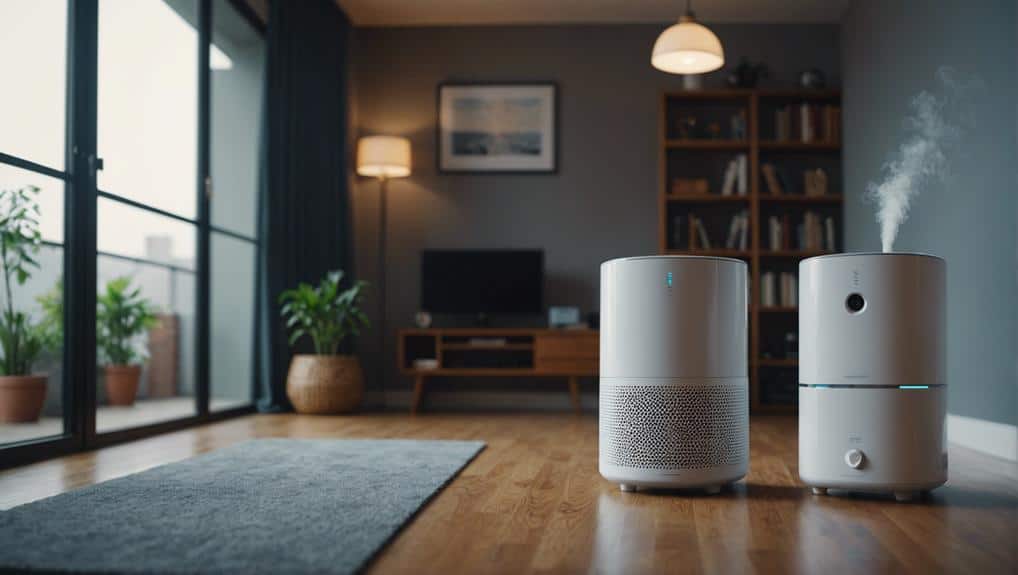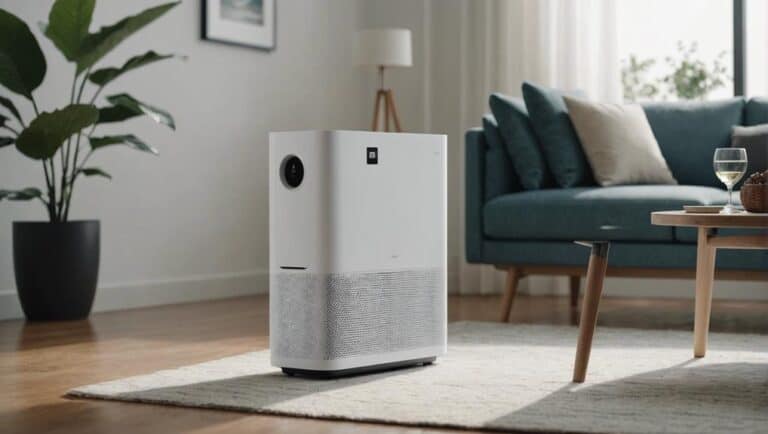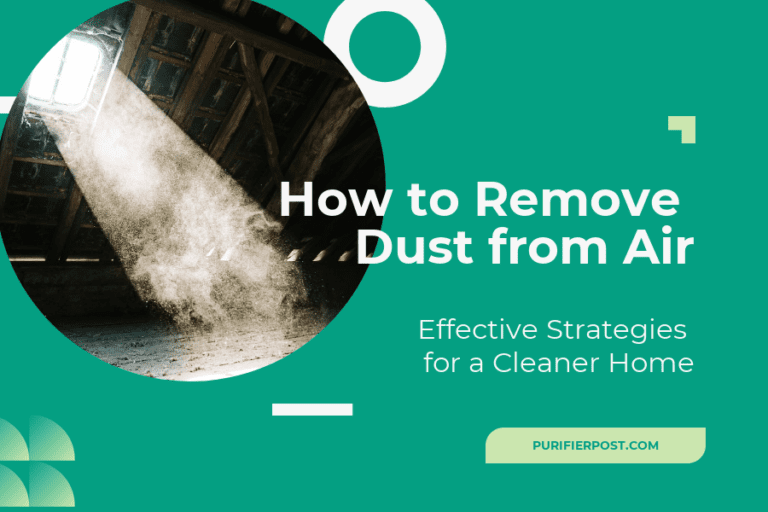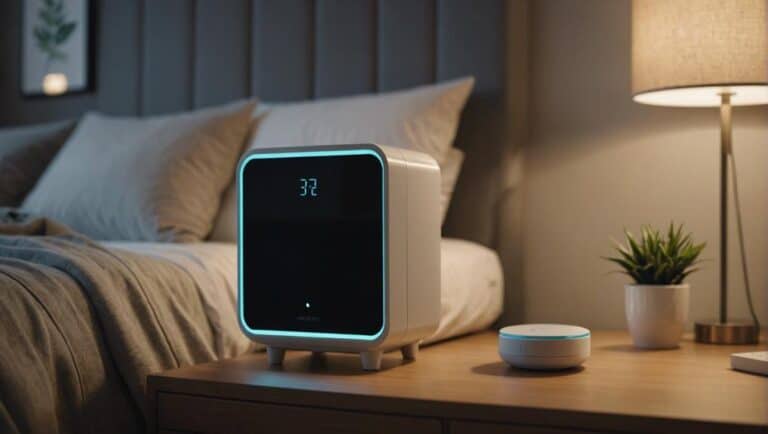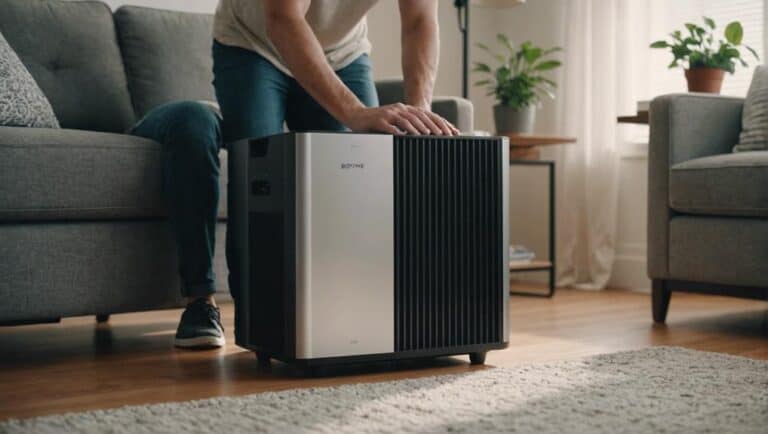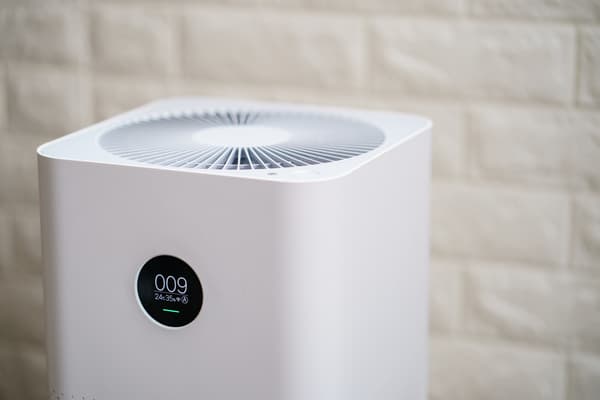Air Purifier Vs Humidifier: 10 Key Differences
As we explore the world of air quality improvement, delving into the domain of air purifiers versus humidifiers reveals intriguing disparities. Understanding the nuances between these two essential devices can have a substantial impact on the overall indoor environment, be it at home or in the office.
The distinctions in purpose, mechanism, and health benefits offer a compelling insight into how each appliance plays a unique role in optimizing indoor air quality. Stay tuned to unravel the ten key differences that could revolutionize your approach to creating a healthier living space.
Purpose
When comparing air purifiers and humidifiers, it’s important to understand their distinct purposes in improving indoor air quality and comfort.
Air purifiers are designed to enhance indoor air quality by removing pollutants, allergens, and contaminants. Their primary purpose is to capture airborne particles and odors, creating a healthier environment for breathing.
On the other hand, humidifiers serve the purpose of adding moisture to dry indoor air to improve humidity levels. By increasing moisture in the air, humidifiers combat dry air conditions that can lead to issues such as dry skin and respiratory discomfort.
Air purifiers target pollutants and allergens that float in the air, while humidifiers focus on enhancing the moisture content in the environment. Understanding the specific purpose of each device is essential in addressing different indoor air quality concerns effectively.
Mechanism
Let’s break down the mechanism of air purifiers and humidifiers.
Air purifiers operate by filtering out pollutants and allergens from the air using mechanisms like HEPA filters.
Humidifiers work by releasing water vapor to add moisture to indoor environments.
Understanding how air purifiers capture particles and how humidifiers increase humidity levels can help us grasp the distinct ways in which these devices function.
Air Purifier Functionality
Air purifiers operate by utilizing a filtration system to remove airborne particles, targeting allergens, smoke, dust mites, and other contaminants to enhance indoor air quality. These filters are designed to capture a wide range of pollutants, making them efficient in improving the overall air quality within a given room size.
Humidifier Moisture Output
Utilizing various methods such as evaporating water, boiling water into steam, or creating a fine mist through vibrations, humidifiers are designed to increase moisture levels in indoor environments. Ultrasonic humidifiers use vibrations to produce a mist, evaporative humidifiers release water vapor by passing air over a wet filter, while steam vaporizers heat water to create steam for added humidity. Each type of humidifier offers a unique way to increase moisture levels, catering to different preferences for controlling indoor humidity levels. Here is a comparison of the mechanisms used by different types of humidifiers:
| Humidifier Type | Mechanism | Output |
|---|---|---|
| Ultrasonic | Vibrations | Fine mist |
| Evaporative | Air over wet wick/filter | Water vapor release |
| Steam Vaporizers | Heating water | Steam production |
Health Benefits
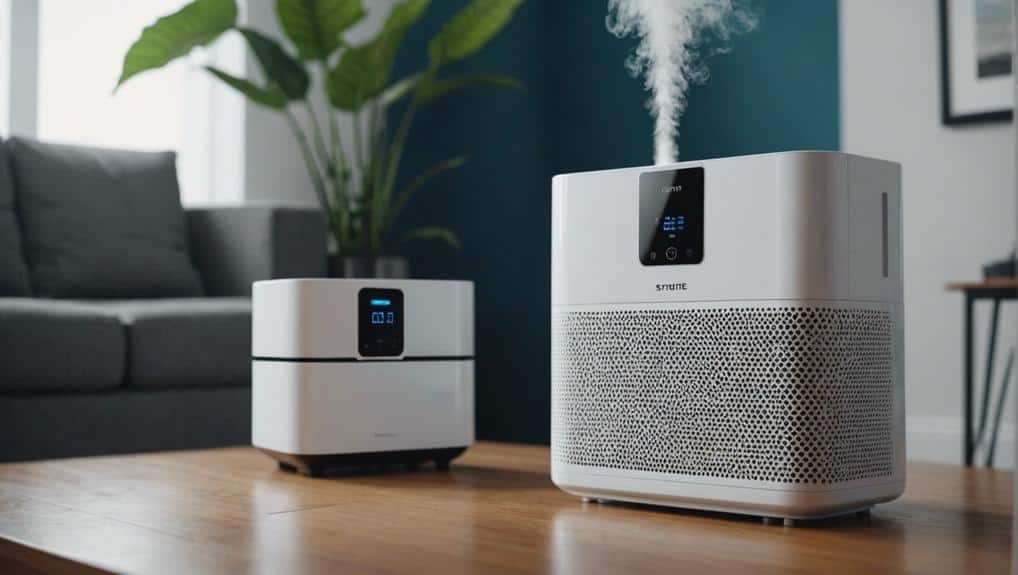
When considering health benefits, both air purifiers and humidifiers offer advantages in different areas.
Air purifiers can enhance air quality by trapping allergens, making it easier for individuals with allergies and asthma to breathe.
On the other hand, humidifiers can prevent dryness effects by adding moisture to the air, which may alleviate discomfort from colds and flu symptoms.
Improved Air Quality
Improving indoor air quality through the use of air purifiers and humidifiers provides numerous health benefits for individuals.
Air purifiers effectively remove pollutants such as dust, pollen, and pet dander, thereby improving indoor air quality and reducing allergy symptoms. On the other hand, humidifiers add moisture to the air, helping to alleviate issues like dry skin and dry throat by maintaining ideal humidity levels.
Air purifiers can also capture and eliminate airborne viruses and bacteria, lowering the risk of respiratory infections. Additionally, humidifiers prevent static electricity buildup and contribute to overall respiratory health and comfort.
When used together, air purifiers and humidifiers create a balanced indoor environment that promotes well-being and enhances overall health.
Prevent Dryness Effects
To maintain essential health benefits, humidifiers play an important role in preventing the discomfort of dry skin, scratchy throats, and other effects of low humidity levels. Dry indoor environments can lead to respiratory issues, which makes maintaining ideal humidity levels crucial.
Adding moisture with a humidifier helps alleviate these problems by keeping the air at ideal humidity levels, typically ranging between 30% to 50%. By preventing dryness and maintaining proper humidity, humidifiers not only enhance comfort but also reduce the spread of germs and viruses.
This control over indoor humidity levels can greatly improve overall well-being and sleep quality in environments where dry air prevails.
Air Quality Improvement
In enhancing air quality, air purifiers effectively filter pollutants and allergens from indoor environments. Air purifiers target airborne particles such as dust, pet dander, mold, and bacteria for thorough filtration. This process greatly improves indoor air quality by reducing the presence of harmful substances that can trigger allergies or respiratory issues.
On the other hand, humidifiers focus on adding moisture to dry air, which is particularly beneficial in areas with low humidity levels. By increasing moisture levels in indoor environments, especially during dry winter months, humidifiers help alleviate dryness and promote a more comfortable atmosphere.
Both air purifiers and humidifiers play important roles in enhancing air quality, albeit through different mechanisms. While air purifiers purify the air by removing pollutants and allergens, humidifiers work to increase moisture levels. By utilizing these devices appropriately, individuals can create a healthier indoor environment that supports respiratory health and overall well-being.
Maintenance Requirements
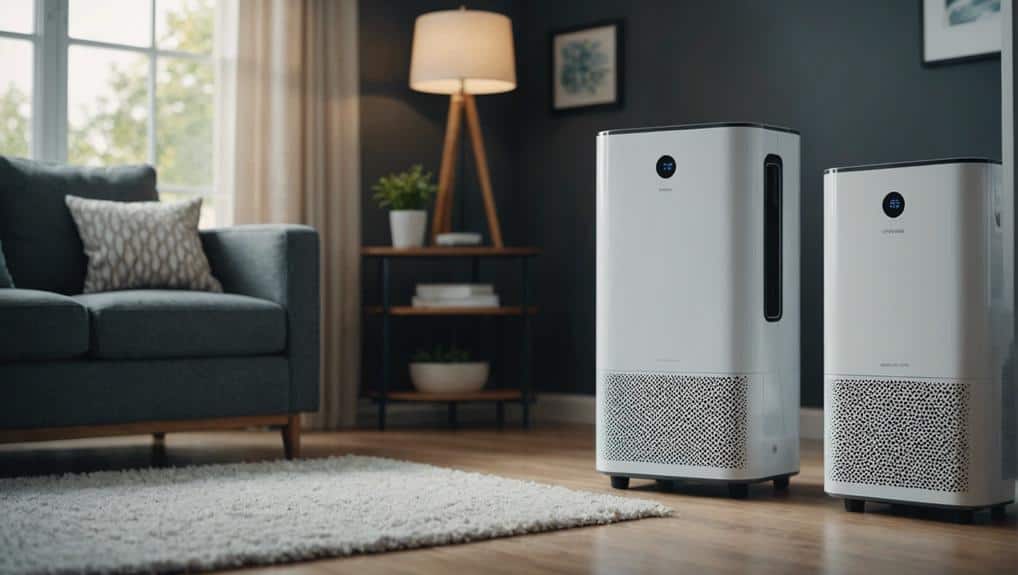
We need to address the cleaning frequency and water tank care when comparing air purifiers and humidifiers.
Air purifiers typically require filter changes every 6-12 months, while humidifiers need regular cleaning to prevent mold and bacteria growth. Proper maintenance is key for keeping both devices running smoothly and effectively.
Cleaning Frequency
Regular maintenance is essential for both air purifiers and humidifiers to guarantee peak performance and prevent potential health hazards. When it comes to cleaning frequency:
- Air purifiers generally require less frequent cleaning compared to humidifiers.
- Humidifiers need regular cleaning and maintenance to prevent mold or bacteria growth.
- Air purifiers usually require filter changes every 6-12 months, depending on usage.
Neglecting the necessary maintenance tasks can lead to reduced efficiency and health risks. It’s vital to follow a regular cleaning schedule to make sure that both air purifiers and humidifiers operate effectively and maintain a healthy indoor environment.
Water Tank Care
To maintain peak performance and prevent harmful microorganism dispersion, diligent cleaning and disinfection of humidifier water tanks are essential.
Regular cleaning and disinfection of the water tank are vital to prevent mold and bacteria growth, which can lead to contaminated air and potential respiratory issues.
Neglecting water tank care increases the risk of dispersing harmful microorganisms into the environment.
Proper maintenance of the water tank guarantees that clean, moisture-rich air is released, promoting a healthier living space.
By routinely changing the water and thoroughly cleaning the water tank, the chances of respiratory problems due to contaminated air from humidifiers are greatly reduced.
Prioritizing water tank care is key to enjoying the benefits of a humidifier while minimizing health risks associated with harmful microorganisms.
Suitable Environments
In environments with high levels of pollutants, allergens, and odors, air purifiers are particularly effective. When considering suitable environments for air purifiers and humidifiers, it’s important to understand the specific needs each device addresses.
- Air Purifiers:
- Ideal for areas with poor outdoor air quality or high levels of indoor pollutants.
- Effective in reducing respiratory irritants like dust, pet dander, and mold spores.
- Recommended for individuals sensitive to allergens or pollutants.
In contrast, humidifiers are best suited for environments suffering from dry air and low humidity levels. These devices can help alleviate issues such as dry skin, static electricity, and respiratory problems caused by excessively dry air. Understanding the unique benefits each device offers allows individuals to make informed decisions based on their environmental conditions and health concerns. By selecting the right appliance for the situation, control over air quality and comfort levels can be effectively maintained.
Technology Used
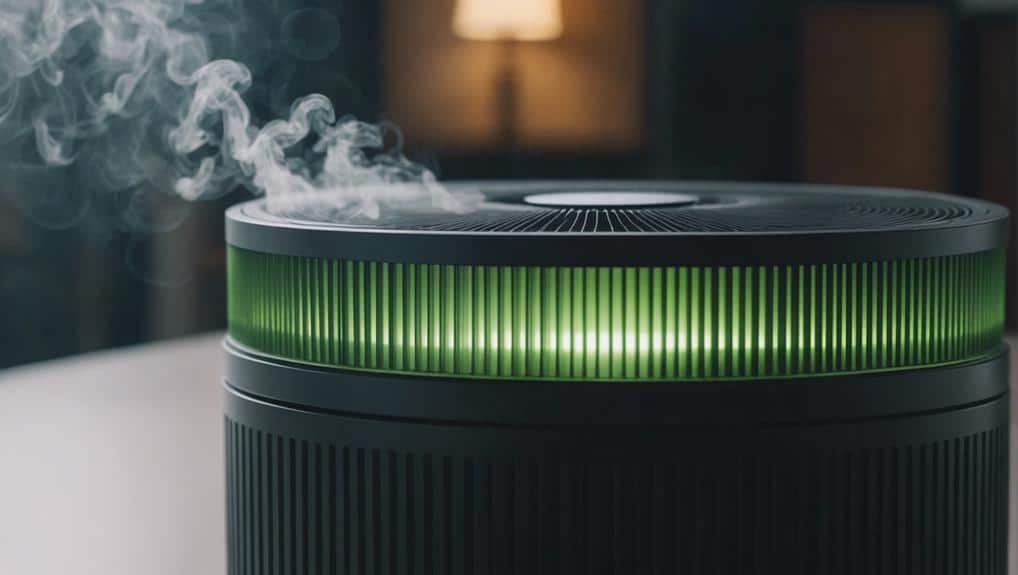
Utilizing advanced filtration and moisture-adding methods, air purifiers and humidifiers employ distinct technologies to enhance indoor air quality and comfort. Air purifiers utilize filtration technologies such as HEPA filters, activated carbon, UV light, or ionizers to eliminate particles like dust, pollen, and pet dander from the air. On the other hand, humidifiers work by adding moisture to the air through methods like evaporating water, boiling water into steam, or using ultrasonic technology. While air purifiers focus solely on cleaning the air by removing pollutants and allergens, humidifiers concentrate on increasing humidity levels in dry indoor environments to maintain ideal moisture levels.
| Air Purifiers | Humidifiers | |
|---|---|---|
| HEPA filters | Add moisture | |
| Activated carbon | Increasing humidity levels | |
| UV light | Filtration technologies | |
Impact on Respiratory Health
Enhancing respiratory health, air purifiers and humidifiers play essential roles in creating a healthier indoor environment. When considering the impact on respiratory health, it’s important to understand how these devices can make a difference:
- Air Purifiers: By using HEPA filters, air purifiers effectively remove allergens such as dust mites, pollen, and mold spores from the air, reducing the risk of respiratory issues caused by these irritants.
- Humidifiers: Maintaining proper humidity levels, humidifiers can alleviate dry air-related respiratory symptoms like coughing and throat irritation, promoting easier breathing for individuals with respiratory problems.
- Combination Approach: Combining the benefits of both an air purifier and a humidifier can create an ideal indoor environment for improved respiratory health, ensuring the air is clean and at the right humidity levels to support respiratory well-being.
For those seeking control over their indoor air quality and looking to address respiratory concerns, utilizing both air purifiers and humidifiers can be a proactive step towards creating a healthier living space.
Energy Consumption

Considering the energy consumption differences between air purifiers and humidifiers, it’s evident that air purifiers typically consume more energy due to their fan and filtration system operation. Air purifiers require energy to run their fans and power the filtration systems, which work continuously to clean the air. The fan speed settings and room size impact the energy consumption of air purifiers.
On the other hand, humidifiers are generally more energy-efficient as they mainly need power for the motor that disperses moisture into the air. Humidifiers prioritize adding moisture to the air rather than filtering and circulating it, resulting in lower energy usage. The intensive air cleaning processes of air purifiers contribute to their higher energy consumption compared to the more straightforward operation of humidifiers.
When considering energy efficiency, humidifiers may be a more suitable choice for those looking to minimize energy consumption while still improving indoor air quality.
Cost Comparison
When comparing the energy consumption of air purifiers and humidifiers, it becomes crucial to consider that air purifiers generally cost more upfront than humidifiers, leading to a key factor in the cost comparison between the two.
In considering the cost differences between air purifiers and humidifiers, several factors come into play:
- Upfront Costs: Air purifiers typically have a higher initial investment compared to humidifiers.
- Operating Costs: The cost of operation for air purifiers can vary based on the model and features, potentially impacting long-term expenses.
- Maintenance: Replacement filters for air purifiers can add to ongoing costs, while humidifiers are usually more affordable to purchase and maintain.
When making a decision between an air purifier and a humidifier based on cost, it’s crucial to weigh not only the upfront expenses but also the operating costs and long-term maintenance requirements to determine the most cost-effective option for your needs.
Conclusion
To sum up, comprehending the key differences between air purifiers and humidifiers is crucial in establishing a healthy indoor environment.
While air purifiers prioritize filtering out pollutants and allergens to enhance air quality, humidifiers introduce moisture to combat dry air and alleviate respiratory issues.
By selecting the appropriate device based on individual needs and requirements, we can guarantee a comfortable and healthy living space for ourselves and our loved ones.
